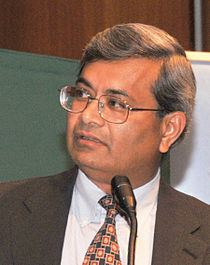Nationality America Name Bhanu Jena | Fields Chemistry | |
 | ||
Born 1 November 1955 (age 69) Orissa, India ( 1955-11-01 ) Notable awards "Distinguished Scientist Award" from SEBM; George E. Palade Medal; Hallim Distinguished Award; Sir. Aaron Klug Award; Ranbaxy Award; Fellow AAAS Education | ||
Bhanu Pratap Jena (born November 1, 1955) is an American cell biologist and the "George E. Palade University Professor and Distinguished Professor of Physiology" at the Wayne State University School of Medicine, who in the mid 90’s discovered the porosome, demonstrated to be the universal secretory machinery at the plasma membrane in cells
Contents

Biography
Jena was born in Jajpur,[6] small town in Orissa, India, on November 1, 1955, to Manju and Prafulla Jena. He majored in Chemistry, Zoology and Botany from BJB College in Bhubaneswar, Orissa, India (B.Sc., 1975) and studied Zoology (Endocrinology) at Utkal University, Orissa, (M.Sc., 1978). Following four years of lectureship at various colleges in Utkal University (1978–82), in 1982 Jena received a teaching and research fellowship from Iowa State University, to pursue studies leading to a doctorate degree. In December 1988, he received his Ph.D. degree in Zoology (Molecular Endocrinology), Following postdoctoral studies at Iowa State and Yale Universities (1988–1994), Jena joined Yale University as an Assistant Professor, and in 2000, joined as Professor in the Department of Physiology, at Wayne State University School of Medicine.
Scientific Discoveries
Using Atomic force microscope on live cells, Jena was the first to report the discovery of a new cellular structure the Porosome in the mid 1990s. The Porosome are permanent supramolecular structures at the cell Plasma membrane, where secretory Vesicle (biology and chemistry) dock and fuse to release intravesicular contents to the outside of the cell. This discovery was a major breakthrough in our understanding of cell secretion. The Porosome, has been determined as the universal secretory machinery in cells, from exocrine cells of the pancreas, to neuroendocrine cells, and neurons. Jena and his research team has determined the structure and dynamics of the Porosome in live cells, at nm resolution and in real time. The structure of the Porosome was further confirmed by electron microscopy in whole cells, and in isolated Porosome preparations. The isolated Porosome has been both structurally and functionally reconstituted in lipid membrane, and its composition determined. The discovery of the Porosome, and an understanding of its structure, function, composition, and reconstitution, has opened a new field in cell biology; nano cell biology[3].
Awards
Among some of the honors and awards Professor Jena has received are, Fellow of American Association for the Advancement of Science (AAAS), Elected Foreign Member of the Georgian National Academy of Sciences (GNAS), Elected Foreign Member of the Korean Academy of Science & Technology, Elected Foreign Member of the Romanian Academy of Medicine, the Ranbaxy Award, the Hallim Distinguished Award Lecture jointly with Prof. Ahmed H. Zewail (the 1999 Nobel Laureate in Chemistry), the Sir. Aaron Klug Award (Prof. Klug is the 1982 Nobel Laureate in Chemistry), the 2005 George E. Palade Medal, six Honorary Doctorates including one from Babes-Bolyai University, Romania, jointly with Professors George E. Palade (the 1974 Nobel Laureate in Physiology or Medicine) and Gunter Blobel (the 1999 Nobel Laureate in Physiology or Medicine), and Distinguished Visiting Professorships at numerous academic institutions around the world [3].
